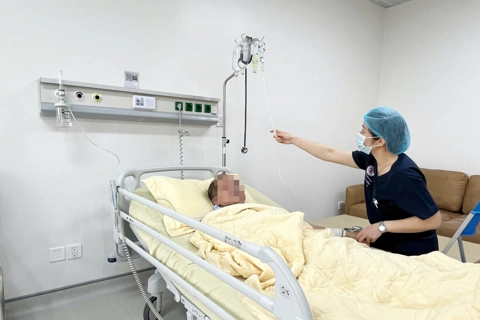Hanoi to slash number of wards and communes
The approach preserves tradition and emotional ties to historically significant areas, while also garnering overwhelming community support.
THE HANOI TIMES — Hanoi has announced its plan to restructure administrative units that reduce the number of communes and wards from 526 to just 126, said Tran Dinh Canh, Director of the city’s Department of Home Affairs at a session of the Hanoi People's Council in late April.
"With 100% of the delegates voting in favor, the Hanoi People's Council passed the resolution on the arrangement of Hanoi's commune-level administrative units," Canh said.
Under the restructuring option, 18 wards of downtown Hoan Kiem District will be merged into two, with the proposed names of Hoan Kiem and Cua Nam. In Ba Dinh District, 13 wards will be merged into three, Ba Dinh, Ngoc Ha, and Giang Vo.

A corner of Hanoi seen from above. Photo: An Chi/The Hanoi Times
"The reorganization of administrative units at the commune level gains public support and the current shortcomings will be solved," Canh said.
He added that the new administrative unit with the smallest area is Cua Nam Ward in Hoan Kiem District covering 1.65 square kilometers, while the largest is Ba Vi Commune in Ba Vi District occupying 81.29 square kilometers. In terms of population, Hong Ha Ward in Tay Ho District is the most populous with more than 126,000 people, while Minh Chau Commune in Ba Vi District is the least populous with more than 6,600 people.
On April 18, Tran Sy Thanh, Chairman of the Hanoi People's Committee, said at a meeting with voters before the 9th session of the 15th National Assembly that the new leadership apparatus will include Party Committees, People's Councils, and People's Committees of wards and communes after the reorganization.
"This measure aims to ensure the stability and smooth operation of the government apparatus in the new units," Thanh said.
The mayor noted that the very high consensus on the reorganization plan (the lowest approval rate for naming was 96%, while most units achieved 100% consensus) demonstrates strong public support for the city-level policy.
The Hanoi People's Committee planned to submit the reorganization project to the government and the National Assembly by early May.
Trích dẫn
Dong Da District's 17 wards will be merged into five, Long Bien's 13 into four, Tay Ho's eight into two, Cau Giay's eight into three, Ha Dong's 15 into five, Hoang Mai's 14 into seven, Thanh Xuan's 11 into three, Bac Tu Liem's 13 into five, and Nam Tu Liem's 10 into four.
A new administrative unit, Hong Ha Ward, with an area of 16.61 square kilometers and a population of about 126,000, will be established. This ward will be formed by merging Chuong Duong and Phuc Tan wards (Hoan Kiem); Phuc Xa (Ba Dinh); most of Nhat Tan, Tu Lien, and Yen Phu (Tay Ho); Bach Dang and Thanh Luong (Hai Ba Trung); and parts of Phu Thuong and Quang An (Tay Ho) and Ngoc Thuy and Bo De (Long Bien).
Meanwhile, Son Tay Town and 17 rural districts, which together cover 91% of the city's area, are home to nearly 58% of its population. Under the plan, Son Tay's 13 administrative units will be merged into just three.











